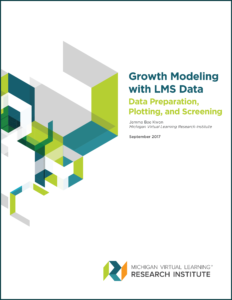Abstract:
 MVLRI® has led various types of quantitative research over recent years. Those studies capitalized on data from the learning management system (LMS) and employed diverse analytic approaches in order to enhance our understanding of topics ranging from class size to students’ engagement patterns in courses. Those resources provide stakeholders opportunities to use the information and knowledge shared in these reports to extract, analyze, and interpret data to better track students’ learning activities, understand learners’ behavior in online courses, and identify their needs. In line with this idea, MVLRI launched a new project that focused on growth modeling. This report describes practical preliminary steps prior to fitting the LMS data into the growth model.
MVLRI® has led various types of quantitative research over recent years. Those studies capitalized on data from the learning management system (LMS) and employed diverse analytic approaches in order to enhance our understanding of topics ranging from class size to students’ engagement patterns in courses. Those resources provide stakeholders opportunities to use the information and knowledge shared in these reports to extract, analyze, and interpret data to better track students’ learning activities, understand learners’ behavior in online courses, and identify their needs. In line with this idea, MVLRI launched a new project that focused on growth modeling. This report describes practical preliminary steps prior to fitting the LMS data into the growth model.
Written By:
Jemma Bae Kwon, Michigan Virtual Learning Research Institute
What We Already Know About This Topic:
- Growth modeling is one of the approaches used to analyze data collected over time and can be used to depict developmental changes or patterns of behavioral changes.
- Timestamped data in an LMS can be easily transformed to the longitudinal data that enable us to investigate changes in student behaviors in the course over time.
- In the context of K-12 online learning, we found a study whose methodology focused on both aspects of the trajectory of behavior and identification of learner groups. The study analyzed time recorded in the LMS and found the six pattern-based groups, including the group profiled as “Steady engagement of approximately 1.5 hours per week” as the largest group.
What This Report Adds:
- By describing actions to be taken to investigate data from an LMS using the growth modeling framework, this report provides information that allows other online learning providers to adopt or replicate similar academic analytics. After deciding on the measurement occasion as month-by-month, data were cleaned up by removing entries for the day, hour, minute, and second from each timestamp cell. The final data set contained individual students’ greatest earned score, month by month.
- After deciding on the measurement occasion as month-by-month, data were cleaned up by removing entries for the day, hour, minute, and second from each timestamp cell. The final data set contained individual students’ greatest earned score, month by month. The data plot process informed us of outliers and overall patterns of trajectories in a particular semester as well as across semesters.
- The data plot process informed us of outliers and overall patterns of trajectories in a particular semester as well as across semesters.
- The data screening process reiterated our observations on the characteristics of data that appeared in plots. Based on the results from our preliminary steps, latent class growth analysis under the growth mixture modeling framework was chosen as our modeling approach.
Implications for Practice and/or Policy:
Analytics help schools enhance their competitive advantage and identify areas to improve. This report offers a demonstration of data preparation and screening to fit timestamped data into the rigorous analytic approach of growth modeling. The following report of results from the latent class growth analysis will present data-driven learner groups based on their trajectories of course behavior throughout the semester, and thus carry further implications, specifically for instructional practitioners.